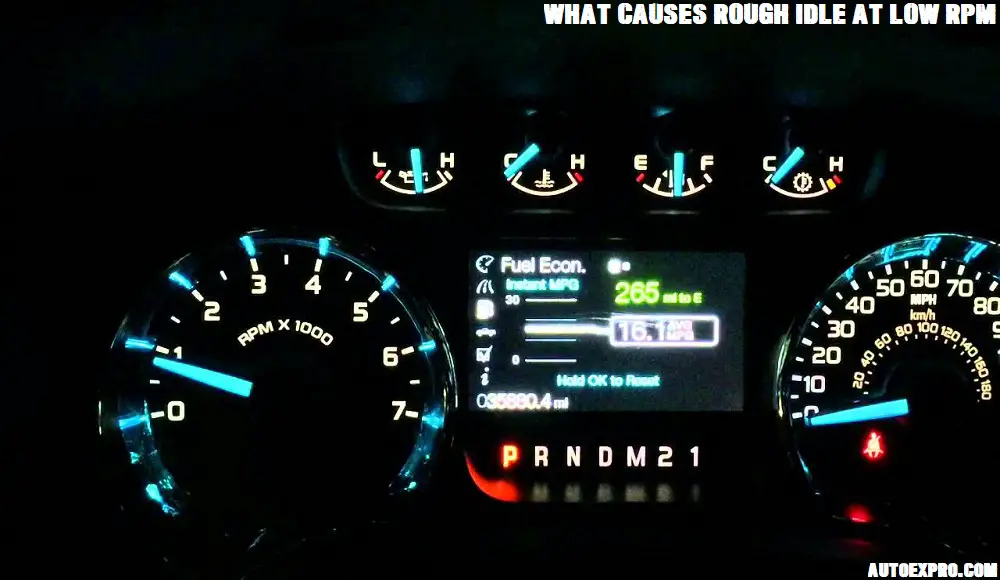
Everyone wants a smooth-performing car that shifts properly and doesn’t shake due to internal reasons.
However, if you hear noises, shaking, or slapping sounds from your car, then take into account the rough idle, which can help resolve the problem. But what causes rough idle at low rpm?
That is what we’re putting forth in the article, some common and easily solved problems for rough idle at low rpm and how you can easily identify it when you hear a noise coming from your car’s engine.
What is Idling in a Vehicle?
Idling is that your vehicle has the power to work the steering but doesn’t have the power to move the car. If you see that your vehicle is skidding or slipping, you have rough idling issues and need to solve the problem immediately.
However, in idle, the car feels smooth, and no noise can make you think there’s an issue under the hood. Although, you should have sufficient knowledge to identify everything going on with the vehicle you’re driving.
What Causes Rough Idle at Low RPM of Your Vehicle
Rough idling can happen for many reasons, for instance – incorrect setting, faulty parts, or even issues with the electronics. Here are some of the most common reasons for your vehicle to have rough idling and solutions –
1. Issues with the PVC Valve
The PVC valve endures a lot of stress in your vehicle as it takes the unburnt gases from the positive crankcase takes it to the engine to complete the burn so that your car moves forward.
However, due to heavy stress and contamination, the PVC valve gets blocked and also can cause leakage. That can lead to rough idling.
Changing or replacing, in that case, is the best option. Moreover, you can clean the PVC from time to time to prevent such incidents.
2. Blockage in the Fuel Pump
Fuel is an important component of your vehicle as it helps the car move. However, if the fuels are unable to reach the fuel injectors for a faulty fuel pump, it might be the reason behind the rough idling of your car.
It happens mostly because of a clogged pump line, and servicing your vehicle every year or so is a way to prevent such problems.
3. Vacuum Leakage
Vacuum hoses are plenty in your car and over time these hoses crack and even leak. It is a very common reason for your vehicle’s rough idle. Moreover, you can also face engine misfire due to leakage in the vacuum hoses.
If you have a leak in the vacuum hose, everything will run as it is, but in high RPM, you’ll face rough idle. The best option is to check the computer codes to see which hose is leaking and then replace it as soon as possible.
4. Clogged Fuel Filter
The fuel filter allows all the impurities from fuel to screen out so that your vehicle gets the raw fuel it requires to run.
Filters, over time, get clogged with gunk and all the impure materials from the fuel. That then blocks the smooth flow of the fuel to your car’s engine.
In that case, in low RMP, you’ll see rough idle, and also sometimes you can also see that your vehicle is slowing down or accelerating very slowly.
Cleaning and frequently changing the filter is the only way to solve the problem.
5. Issues with the Carburetor or Throttle
Most vehicles nowadays do not have carburetors; however, that does not mean there’re no vehicles with carburetors on the road.
These parts emit black smoke from the exhaust. Moreover, it causes not only rough idle but also other issues to your vehicles.
So, firstly, check the choke once the car is warm. If it opens, it’s probably an internal carburetor issue, and you need a mechanic ASAP.

6. Problematic Airflow Sensors
The fuel isn’t the only component for the car to run; you also need enough airflow through the fuel injector. That’s what the airflow sensor is for in your vehicle as it checks how much air is going into the fuel injector. That measures if the fuel is getting enough amount of air.
These sensors can get dirty and blocked, which can be a reason for your car’s rough idle. So, how can you know that the problem is the airflow sensor? You’ll see your machine stalling or slowing down suddenly. Changing the part is the cheapest and fastest solution.
7. EGR Valve Gone Bad
The EGR or exhaust gas recirculation is a gas emission control device that allows the gas to enter the intake manifold. If it runs when the car is completely warmed up or at open throttle, it will affect the engine and lead to rough idle.
That doesn’t happen as the EGR is well built; however, if it malfunctions, this can happen. Your vehicle’s computer will let you know if the component has any issues, and then the first thing to do is clean the ERG and test the car. If that does not solve the problem, buy a new one and replace the old one.
8. Oxygen Sensors
Is the check engine light on? Then there’s an issue with the oxygen sensor of your vehicle. It detects the amount of oxygen that is present in the exhaust line and maintains the emission. If the part fails, a rough idle can happen and also, and you’ll see the check engine light as an indication.
Keeping the component clean and maintaining it as frequently as possible is best to avoid failure.
9. The Ignition Coil is Faulty
The ignition coil works along the spark plug to light up the fuel for the car to run. If you face a misfire or poor fuel economy, then it’s the ignition coil that is faulty.
So, check the connection, and if there’s an issue, then change it, and it’ll instantly solve your rough idle issue.
10. Temperature Sensors Are Not Working Properly
The car requires different fuel mixtures depending on the engine’s temp. That is why manufacturers put in a temperature sensor to detect and supply what is needed according to the temp of the engine. If that component malfunctions, facing rough idle is the smallest of your problems.
11. Compression is Low
You can easily identify low compression in your vehicle in idle as you will face misfires. If your car runs more than 100000 miles, it’s very common to happen.
So, is it causing the rough idle situation? Check the cylinders, and if the compression pressure is low in one, then it is what is causing the problem.
it is not that easy to solve as the engine needs to be disassembled, and you might also need to replace the valves.
How to Fix Rough Idle at Low RPM
FAQs About Rough Idle at Low RPM
How do you fix a rough idle?
Most rough idle situations happen due to gunk or carbon deposits in the components. The best way is to get a carburetor cleaner that is cheap and can help you clean up all the filth in all the components.
Why does my car idle rough when I stop?
It’s probably because of a bad fuel pump which not allowing the car to start. A clogged fuel filter may also cause the issue. In that case, change, replace or clean the pump and filter as frequently as possible to decrease or prevent the problem.
Can low transmission fluid cause rough idle?
Yes, it can. It won’t happen instantly, but it can foul the plugs over time, which leads to rough idle. However, modern vehicles don’t face this problem as the transmissions are electronic and there is a vacuum modulator.
Can a clogged catalytic converter cause rough idle?
Yes, it can. Clogging of any catalytic converter can cause the issue. In that case, using a vacuum gauge in the exhausts backpressure gauge or on the intake manifold after installing the new converter.
How can I increase the RPM of idle?
The easiest way is to use the idle screw. Rotate it counter-clockwise, and that way, you can increase your vehicle’s RPM. The perfect resting point for the idle is 650 RPM.
Conclusion
Rough idle happening to a vehicle is a hassle, and identifying what is causing it to occur isn’t that simple.
That is why we shared what causes rough idle at low RPM to get an in-depth overview of each reason and how you can solve it easily.
Leave a Reply